
The primary purpose of bathroom ventilation used to be to keep condensation and mould under control, but this is no longer sufficient today. The experts at Vent-Axia explain why the sound of silence is so critical to your customers’ fan experience.
We all recognise the annoying drone of a bathroom fan that sounds as though it has seen better days. In the past, sound may not have been a top consideration when installing a bathroom extract fan. The main aim was for a healthy and mould-free bathroom and so an extractor fan may have been seen by many as purely functional. However, modern households are demanding more from their extractor fans and it is not enough for the bathroom fan to only provide good indoor air quality.
A quiet environment is now so important that customers are prepared to pay more for a silent extractor fan.
The average extract fan operates at 35 decibels. This is loud in a confined space.
So what steps do you need to take to achieve a tranquil bathroom? Here are some tips to help achieve optimum peace and quiet…
- Selecting a fan: The first step is to select a silent extractor fan. Manufacturers have been working hard to improve the acoustics of bathroom extractor fans and so electricians can now easily select the right fan for the job. For instance, there are fans out there that operate on the threshold of human hearing with intermittent bathroom fans operating at only 14dBA and continuous ventilation options coming in at a virtually inaudible 10dBA. Continuous fans extract all the time but at a lower rate. As well as being a more energy efficient option, the lower the fan speed, the quieter the fan.
- Third Party Accreditation: Consumers are impressed by third-party accreditation of products, which acts as a good selling point for silent fans. The seal of approval for these products is the Quiet Mark. A mark of approval awarded by the Noise Abatement Society, the Quiet Mark is given World-Wide to manufacturers of the quietest products on the market and is validated by the UK’s Association of Noise Consultants. The initiative’s objective is to reduce noise and so achieve a healthier stress-free living and working environment. The Quiet Mark award enables quieter products to easily be selected via the online Quiet Mark Directory quietmark.com
- Select the right size fan: Ensure the fan fits the needs of a bathroom, do not oversize a fan. The more powerful a fan potentially the noisier a fan will be. Also, avoid long duct runs that may result in excessive levels of air resistance which can be noisy.
- Motors: Select extractor fans with high efficiency motors since the ball bearing technology used in them offers smoother and therefore quieter performance. High efficiency motors will also last longer, meaning the fan won’t get noisier over time.
- Silent scheduling: The latest bathroom fans offer App Control with silent scheduling and automatic cycles, offering flexible ventilation to suit a household’s lifestyle. Silent scheduling allows the homeowner to ensure that the fan does not go to boost which is particularly useful overnight, or if there is a sleeping baby nearby.
- Avoiding nuisance running: Quiet, disturbance free running is the holy grail of ventilation. Good options to look out for are: clever light sensors that recognise room occupancy through light movement and shadows; a delay-on feature that can be set to avoid the fan being triggered in the night during quick bathroom visits; and fans that don’t trigger at ambient humidity changes in the night.
- Siting the fan: The ideal site to achieve best performance and keep noise levels to a minimum is the shortest route to outside. If possible, for the quietest installations of bathroom extractor fans, mount a fan directly through an outside masonry wall. Where possible avoid mounting fans on plasterboard ceilings or stud partition walls since the vibration may amplify noise.
With technological change advancing, consumers are becoming increasingly demanding with regards to comfort, health and wellbeing in their homes. Indoor air quality and silent products are central to household comfort. The time is therefore now for electricians to make their customers aware of the latest generation of silent extractor fans that offer the level of comfort and control demanded in the home.
Still not convinced about silence? The question then is how quiet is quiet? Well ‘Hearing Really is Believing’ so hear for yourself how quiet an extractor fan can be at https://www.vent-axia.com/silentfan
To find out what goes into the process of making a quality fan click here and to hear customer feedback of the product watch below:








